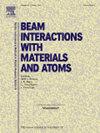Radiation shielding properties of tungsten alloy multileaf collimator materials in linear accelerator
IF 1.4
3区 物理与天体物理
Q3 INSTRUMENTS & INSTRUMENTATION
Nuclear Instruments & Methods in Physics Research Section B-beam Interactions With Materials and Atoms
Pub Date : 2025-04-24
DOI:10.1016/j.nimb.2025.165709
引用次数: 0
Abstract
Investigating the radiation shielding properties of tungsten (W) alloys is essential for minimizing radiation leakage in multileaf collimators (MLC). In this work, the radiation shielding properties of six different tungsten alloy MLC materials are evaluated over photon energies ranging from 0.015 to 15 MeV using XCOM and Phy-X / PSD software. Results, partial photon interaction cross section varied with photon energy and the elemental composition of the alloys. The sample S6 with 97 % W exhibits the highest mass and linear attenuation coefficients. The effective atomic number (Zeff) and electron density (Neff) vary with energy and composition, with S6 showing the highest Zeff. The mean free path, half value layer, and tenth value layer peak at intermediate energies. Sample S6 also exhibits the lowest exposure buildup factor and highest radiation protection efficiency %, including clinical Co60 gamma rays and FFF 6 MV X-rays. This study will be useful for MLC design.
直线加速器中钨合金多叶准直材料的辐射屏蔽性能
研究钨合金的辐射屏蔽性能对减少多叶准直器的辐射泄漏至关重要。利用XCOM和Phy-X / PSD软件,在0.015 ~ 15 MeV的光子能量范围内,对6种不同钨合金MLC材料的辐射屏蔽性能进行了研究。结果:部分光子相互作用截面随光子能量和合金元素组成的变化而变化。含有97% W的样品S6表现出最高的质量和线性衰减系数。有效原子序数(Zeff)和电子密度(Neff)随能量和组成的不同而变化,其中S6的Zeff最高。平均自由程、半值层和十值层在中间能量处达到峰值。样品S6也表现出最低的暴露累积因子和最高的辐射防护效率%,包括临床Co60伽马射线和fff6 MV x射线。本研究对MLC的设计有一定的指导意义。
本文章由计算机程序翻译,如有差异,请以英文原文为准。
求助全文
约1分钟内获得全文
求助全文
来源期刊
CiteScore
2.80
自引率
7.70%
发文量
231
审稿时长
1.9 months
期刊介绍:
Section B of Nuclear Instruments and Methods in Physics Research covers all aspects of the interaction of energetic beams with atoms, molecules and aggregate forms of matter. This includes ion beam analysis and ion beam modification of materials as well as basic data of importance for these studies. Topics of general interest include: atomic collisions in solids, particle channelling, all aspects of collision cascades, the modification of materials by energetic beams, ion implantation, irradiation - induced changes in materials, the physics and chemistry of beam interactions and the analysis of materials by all forms of energetic radiation. Modification by ion, laser and electron beams for the study of electronic materials, metals, ceramics, insulators, polymers and other important and new materials systems are included. Related studies, such as the application of ion beam analysis to biological, archaeological and geological samples as well as applications to solve problems in planetary science are also welcome. Energetic beams of interest include atomic and molecular ions, neutrons, positrons and muons, plasmas directed at surfaces, electron and photon beams, including laser treated surfaces and studies of solids by photon radiation from rotating anodes, synchrotrons, etc. In addition, the interaction between various forms of radiation and radiation-induced deposition processes are relevant.

 求助内容:
求助内容: 应助结果提醒方式:
应助结果提醒方式:


